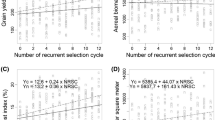Summary
Yield data were collected for soybean (Glycine max (L.) Merr.) lines in maturity groups III and IV in 14 environments from 1985 to 1989. The lines in each maturity group were subdivided into three different groups based on the mean yield over all environments, and the genotype × environment interactions were studied for each group. Yield stability of the lines was determined. Effectiveness of selection based on different types of environments was examined.
Productivity level of the environment did not influence the relative ranking of the lines. Significant rank correlations occurred between mean yields in most environments and the overall mean yield, but few similarities occurred in the line rankings among individual environments. High-yielding lines contributed a significantly smaller proportion to the genotype × environment interaction than medium- and low-yielding lines.
A small proportion of the lines were below or above average stability. Significant correlations occurred among stability, overall mean yield, and mean yield in high- and low-yielding environments. However, few significant correlations occurred between individual environment yields and stability in high- or low-yielding environments. Maturity groups differed in yield and stability relationships. Stability in high- and low-yielding environments did not adequately predict stability for each other.
Similar content being viewed by others
References
Adegoke A.O. & K.J.Frey, 1987. Grain yield response and stability for oat lines with low-, medium-, and high-yielding ability. Euphytica 36: 121–127.
Allen F.L., R.E.Comstock & D.C.Rasmusson, 1978. Optimal environments for yield testing. Crop Sci. 18: 747–751.
Baihaki A., R.E.Stucker & J.W.Lambert, 1976. Association of genotype × environment interactions with performance level of soybean lines in preliminary yield tests. Crop Sci. 16: 718–721.
Byth D.E., C.R.Weber & B.E.Caldwell, 1969. Correlated truncation selection for yield in soybeans. Crop Sci. 9: 699–702.
Eberhart S.A. & W.A.Russel, 1966. Stability parameters for comparing varieties. Crop Sci. 6: 36–40.
Finlay K.W. & G.N.Wilkinson, 1963. The analysis of adaptation in a plant-breeding program. Aust. J. Agric. Res. 14: 742–754.
Fox P.N. & A.A.Rosielle, 1982. Reducing the influence of environmental main-effects on pattern analysis of plant breeding environments. Euphytica 31: 645–656.
Frey K.J., 1964. Adaptation reaction of oat strains selected under stress and non-stress environmental conditions. Crop Sci. 4: 55–58.
Langer I., K.J.Frey & T.Bailey, 1979. Associations among productivity, production response, and stability indexes in oat varieties. Euphytica 28: 17–24.
Pham H.N. & M.S.Kang, 1988. Interrelationships among and repeatability of several stability statistics estimated from international maize trials. Crop Sci. 28: 925–928.
Rosielle A.A. & J.Hamblin, 1981. Theoretical aspects of yield in stress and non-stress environments. Crop Sci. 21: 943–946.
Saeed M. & C.A.Francis, 1983. Yield stability in relation to maturity in grain sorghum. Crop Sci. 23: 683–687.
SAS Institute Inc., 1985. SAS User's Guide: Statistics, Version 5 Edition. Cary, NC: SAS Institute Inc. 956 pp.
Smith R.R., D.E.Byth, B.E.Caldwell & C.R.Weber, 1967. Phenotypic stability in soybean populations. Crop Sci. 7: 590–592.
Vela-Cardenas M. & K.J.Frey, 1972. Optimum environment for maximizing heritability and genetic gain from selection. Iowa State J. Sci. 46: 381–394.
Walker A.K. & W.R.Fehr, 1978. Yield stability of soybean mixtures and multiple pure stands. Crop Sci. 18: 719–723.
Weaver D.B., D.L.Thurlow & R.M.Patterson, 1983. Stability parameters of soybean cultivars in maturity groups VI, VII, and VIII. Crop Sci. 23: 569–571.
Whitehead W.F. & F.L.Allen, 1990. High-vs. low-stress yield test environments for selecting superior soybean lines. Crop Sci. 30: 912–918.
Zavala-Garcia F., P.J.Bramel-Cox, J.D.Eastin, M.D.Witt & D.J.Andrews, 1992. Increasing the efficiency of crop selection for unpredictable environments. Crop Sci. 32: 51–57.
Author information
Authors and Affiliations
Additional information
Contribution No. 93-445-J from the Kansas Agricultural Experient Station
Rights and permissions
About this article
Cite this article
Scott, R.A., Champoux, M. & Schapaugh, W.T. Influence of environmental productivity levels and yield stability on selection strategies in soybean. Euphytica 78, 115–122 (1994). https://doi.org/10.1007/BF00021406
Received:
Accepted:
Issue Date:
DOI: https://doi.org/10.1007/BF00021406




